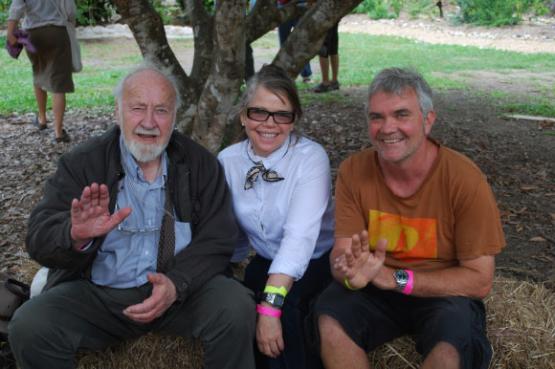
RAW WINE Club - Tasting Notes - February 2024 Selection
37 min read
This month’s selection is an ode to the interconnectedness of our small world, which seems doubly tiny when it comes to natural wine. Both the English Daisy Merrick and French Antoine Lucchesi, from Germany’s SOMA WINES, interned with Michael and Melanie at 2Naturkinder (the grower-makers of Fledermaus in your box) before they met, and they buy their grapes for their Crossing Borders from the wonderful Domaine Brand in Alsace, who also saved the day in Castilla by sending his grapes to Julien for his I am Natural Don’t Panic after the Moroccan Spaniard lost all his grapes to frost. As for Anne, she’s based in the Loire but is making wine off grapes from the Languedoc, while our Chilean Pinot is made by an iconic Burgundian, and our Keep on Punching by South African Craig and his Austrian wife Carla, was made in the foothills of the Cederberg mountains from immigrant Chenin (originally a grape variety from the Loire that has found its own unique expression in its adopted South Africa) sourced from the Swartland.
Enjoy the maze!
Warmest wishes,
Isabelle Legeron MW, Founder of RAW WINE
---
SOMA VINES, Crossing Borders, Alsace, France, 2020
SOMA VINES is a winemaking project by Antoine Lucchesi and Daisy Merrick in Rheinhessen, Germany. It originally began as an importing and distributing company in Berlin, before the pair made their first vintage in 2020, using grapes from Domaine Brand et Fils in Alsace. After that, they established their own presence in Hackenheim, where they now work with grapes from their own vineyards in Rheinhessen.
Q&A with Daisy Merrick
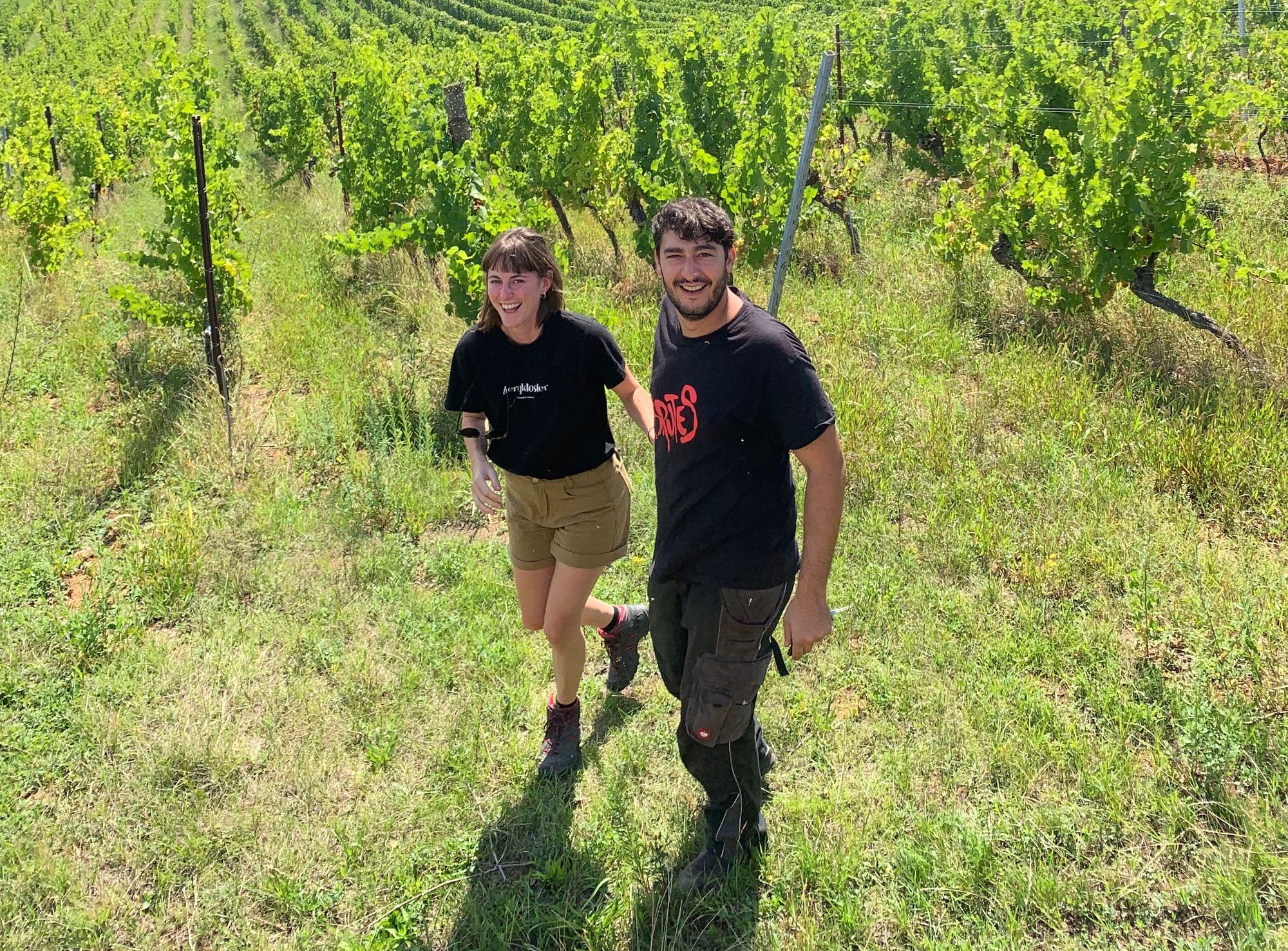
Can you tell me about your and Antoine's backgrounds - at what point did you both decide to start your own project?
Antoine is from Marseille and has a background in wine oenology. He studied in Alsace and worked for people like Domaine Brand et Fils in France and Sekthaus Griesel in Germany. For 10 years, he had been making wine for other people.
I've been in the hospitality industry for around 15 years, and 10 years ago I moved into the wine industry as I wanted to know how to create a unified customer experience. Pairing food and wine. I studied my WSET Advanced in London and worked for Majestic Wine, a huge wine retailer in the UK where I'm from, and then moved to New York City to work for Chamber Street Wines. This is where I discovered natural wine.
From there, I moved to Berlin and started SOMA VINES, originally as an import business. I met Antoine through Domaine Brand et Fils as he was making wine for them and I was importing those wines to Germany. We fell in love and decided to combine our skills and make our own wines together. We've been doing that since 2020.
Who or what has inspired your winemaking practices and philosophy?
We had both worked in the conventional wine industry before entering into the natural wine world.
Antoine wanted to discover another way of winemaking that didn’t include adding chemicals and filtering. The wine that convinced him was Clos Cristal 2014. The first step into natural winemaking for Antoine was working at 2naturkinder in Germany.
For me, it was my experience at Chambers Street Wines. At first, it took me a while to retrain my tastebuds, going from conventional wine to natural, but once I got into it I didn't look back. I don't drink conventional wine anymore, mainly because of how it makes me feel. Domaine Brand et Fils were wines that really stood out to me on the shelves of CSW and when I moved back to Europe, I was thrilled that those wines were not being represented in Germany. I immediately added them to my portfolio.
It's funny actually, I also worked at 2NaturKinder for 3 weeks learning how to prune, a year after Antoine. Before we knew each other, it was like we were already following each other and just didn't know it yet.
Having worked in wine across both Europe and New York, what would you say are the key differences in terms of the natural wine scene and market?
As a 24-year-old, I left Europe and went to New York City in search of new experiences. I was working in the conventional wine industry in London at that time. When I arrived in New York, I was amazed by the vibrant, energetic, and welcoming natural wine scene that already had such an established vibe. Compared to Berlin, where I moved to later and founded SOMA VINES, the scene was quite different. Very welcoming and friendly, but only a handful of places that were representing natural wines back in 2016. It seemed that consumers were not yet convinced by this style of wine. 2024 Berlin is a completely different story. Now flourishing with more natural wine spots all over the city.
Where are you based, and what are the grapes that define the region?
We are in the winemaking region Rheinland-Pfalz in Germany. We were previously in Eckelsheim for 2 years, using the cellar of our winemaker friend, Andi Mann. In 2023 we moved into our own cellar in Hackenheim. Some of the grapes you can find in our region are Riesling, Pinot Noir, Pinot Blanc, Pinot Gris, Silvaner, Dornfelder, Kerner, Müller-Thurgau, Portugieser, Frühburgunder and Chardonnay.
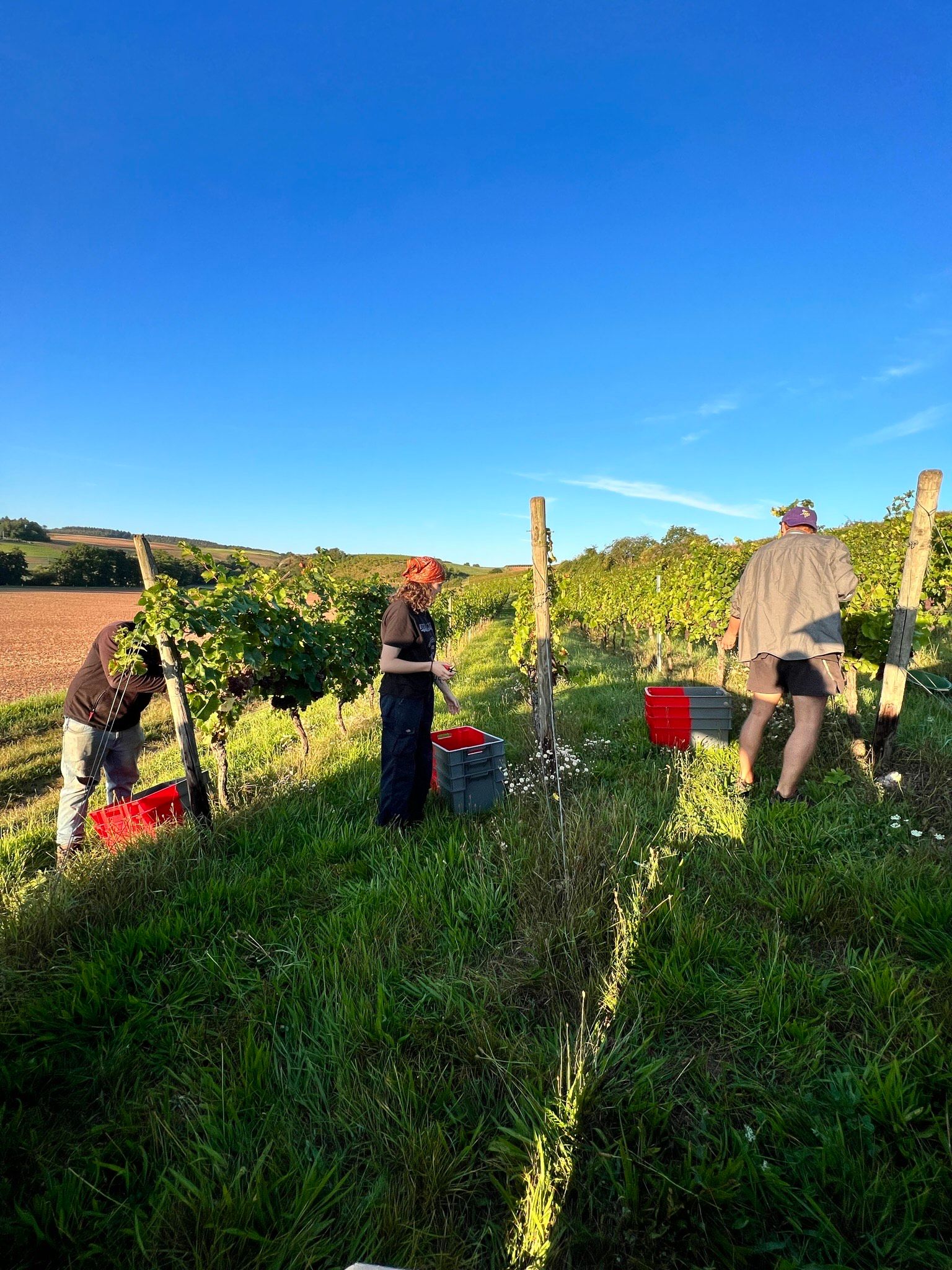
What makes Crossing Borders 2020 different is that the grapes come from Ergersheim in Alsace. We bought Pinot Gris grapes from Domaine Brand et Fils and made this particular wine at his winery in France. Antoine was still working for Philippe Brand at this time and we had asked Philippe if there were some organic grapes that we could use to begin our project. From 2021 onwards, all of our wines have been made in Germany.
What's the soil and climate like in the Alsace vineyard?
The soil is clay and the climate is cool. This particular vineyard is at the bottom of a slope, with trees and a stream at the end of the rows.
What was the winemaking process for this vintage?
The Pinot Gris grapes were picked on the 9th and 10th of September 2020. We left the whole bunches of grapes on their skins for 4 days in a tank and then transferred everything into the press to finish extracting the remaining juice. There had been some Gamay grapes that were pressed just before so we kept the skins of the Gamay to add a little extra colour to the Pinot Gris.
After pressing the grapes, the juice was transferred into another tank and left to ferment. The wine was racked twice and within a week the juice was ready to be bottled to finish fermentation in the bottle. We disgorged the wine on the 22nd of May 2021.
Do you use any sulfites and what are the total sulfites per liter?
We didn't add any sulphites to this wine. You will only find fermented grape juice in this bottle. We try to make all of our wines sulphite-free, but if a wine needs some additional protection, then we would add a max of 10mg/L just before bottling.
What does this wine mean to you?
This wine holds a special place in our hearts as it symbolises the beginning of our journey together. We only produced 1,200 bottles of Crossing Borders Pet Nat, which seems like a side project compared to the 20,000 we made this year. The label was a collaboration between myself, Antoine and our friends Sophia Lietsche and Rocketfuelled Studios in Berlin. It was a very humbling experience to bring these people and their ideas together to create something beautiful for a very special wine. Since 2021, all of our labels have been drawn by my sister, Lilly Winter.
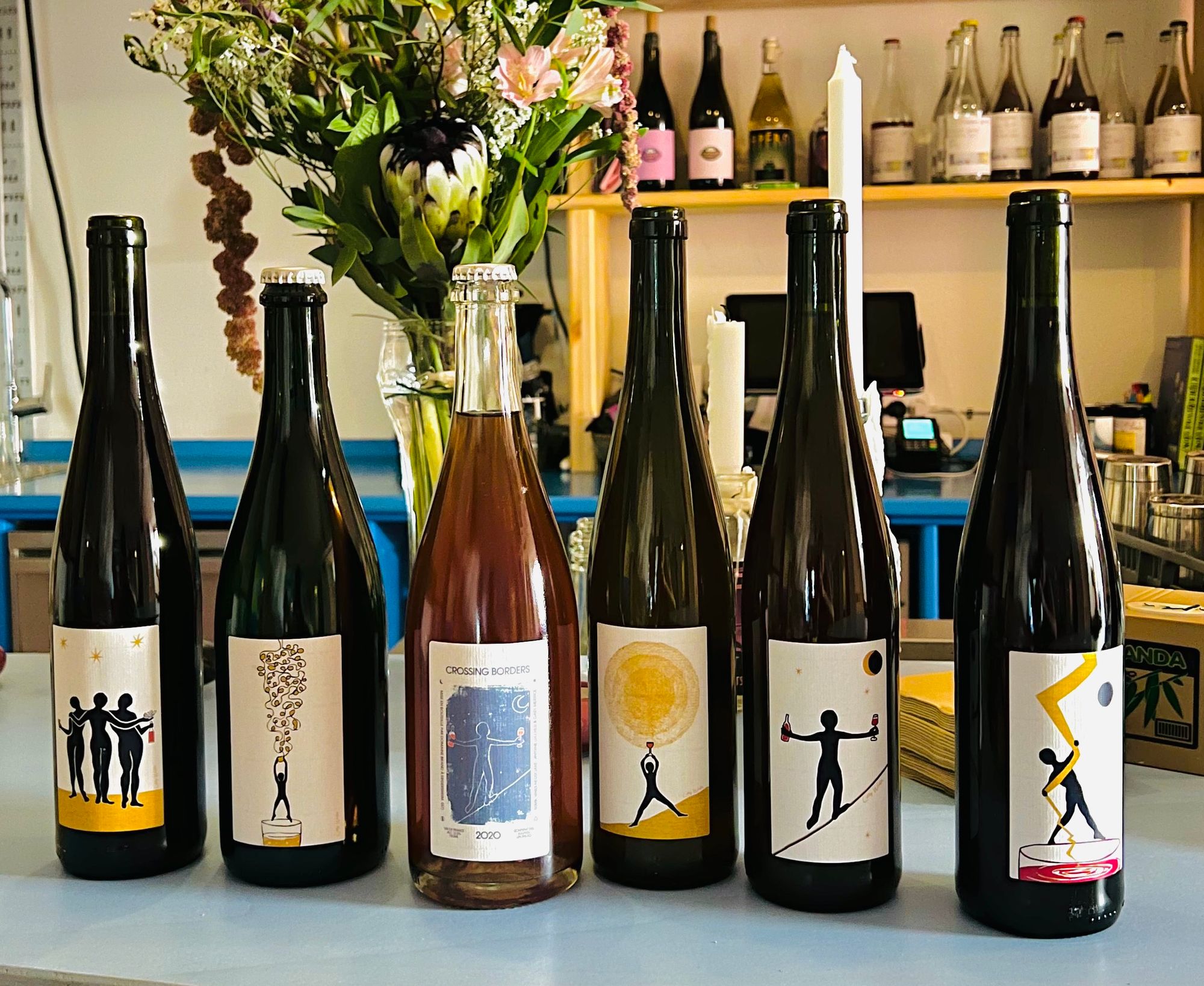
Through this wine, I learned a lot about Pinot Gris on the skins and even more about maceration, and how time has a strong effect on the finished product. It was just 4 days on the skins and from what I can remember taste-wise as it's been sold out in Europe for a while now, is smokey on the palate, crunchy, fresh and energetic with raspberries and cherry flavours. The bubbles are soft on the tongue. I'm intrigued to know what Isabelle Legeron gets from her tasting.
How does this vintage compare to others?
It was the only time we made a Pet Nat from Pinot Gris grapes. In 2021 we made a still wine from the same grapes, same vineyard called 'Still Crossing Borders'. They both had a strong smokey character to them and a good amount of reduction. Since 2022 we've been working with Pinot Gris from Germany for our 'Still Crossing Borders' wine, which is not carrying the smokiness anymore, but more freshness and fruit-focused.
When is it best enjoyed? Now or later, if people want to age it further in the bottle?
I would say it's best to open now.
What’s the story behind the name of the wine, Crossing Borders?
We’re two people both from different lands making wine in Germany. Crossing Borders 2020 were also grapes from Alsace, so the wine also had to cross a border to arrive at our cellar.
Any food pairings you’d recommend?
I can imagine something like fried chicken, babaganoush, roasted salmon or grilled vegetables would work well.
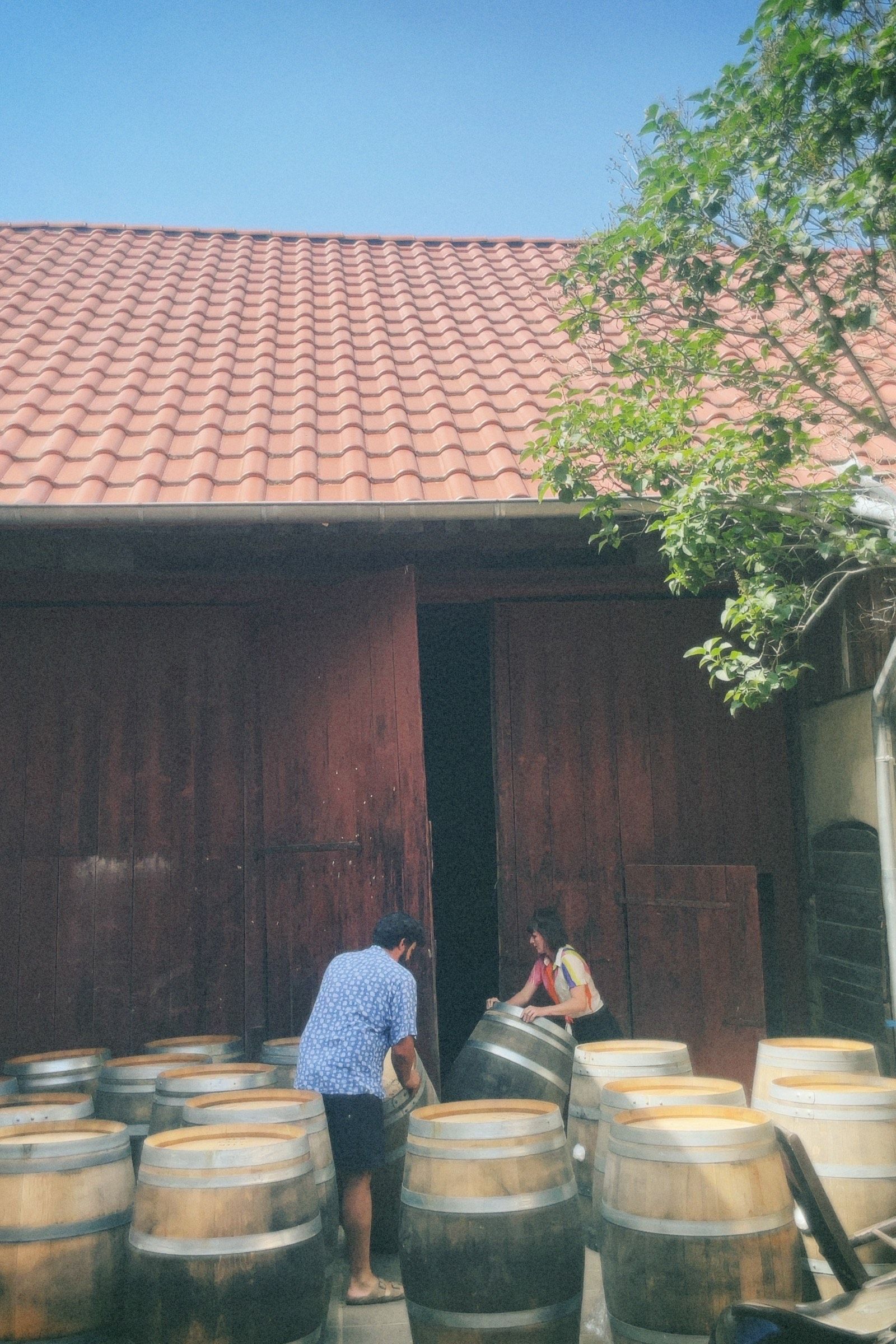
How are things going in Hackenheim so far, and what's on the horizon for SOMA VINES?
We're first-generation winemakers, which comes with a lot of difficulty. Germany is such a big winemaking country, so wineries are often passed down between generations, which makes it hard for people like us to find the perfect space to make wine. We were looking for 2.5 years before we found this place in Hackenheim. We're currently renting our space which has a house and a barn in the back with a cellar.
From this year onwards, we will be working mostly with grapes from the 3 hectares of land that we rent. The soil is mostly clay and sandstone and we have a pretty perfect climate to make fresh, acidity-driven wines. Rheinhessen is the largest winemaking area in Germany and therefore quite flat, but we have some very cute vineyards around. Some are on top of the hill, some are surrounded by a wall that creates a quiet and isolated feeling and we have some views of mountains in the distance.
The plan is to establish ourselves in Hackenheim. Continuing to grow our roots in Rheinland-Pfalz. Cultivating our own parcel of grapes and expanding the cellar so we can increase production, whilst maintaining the quality and elegance of our wines.
Isabelle's thoughts on Crossing Borders - This dark pink, copper-hued rosé has a creamy mouthfeel, fine, elegant bubbles and a dash of tannins. Showing notes of white peach, spicy nutmeg, salty tamarind and moreish sour cherry, this is a bottle with a surprising savoriness that complements the spiciness of Pinot Gris.
TOTAL SULFITES: <10mg/l.
2NaturKinder, Fledermaus, Franken, Germany, 2021
2NaturKinder is a winery on the River Main in Franken, Germany that was taken over by Michael Völker and Melanie Drese in 2013. The estate was first established in 1843. Since then, Michael and Melanie have converted to organic agriculture to produce lively and energetic wines that benefit from a healthy soil and biodiverse environment.
Q&A with Michael Völker
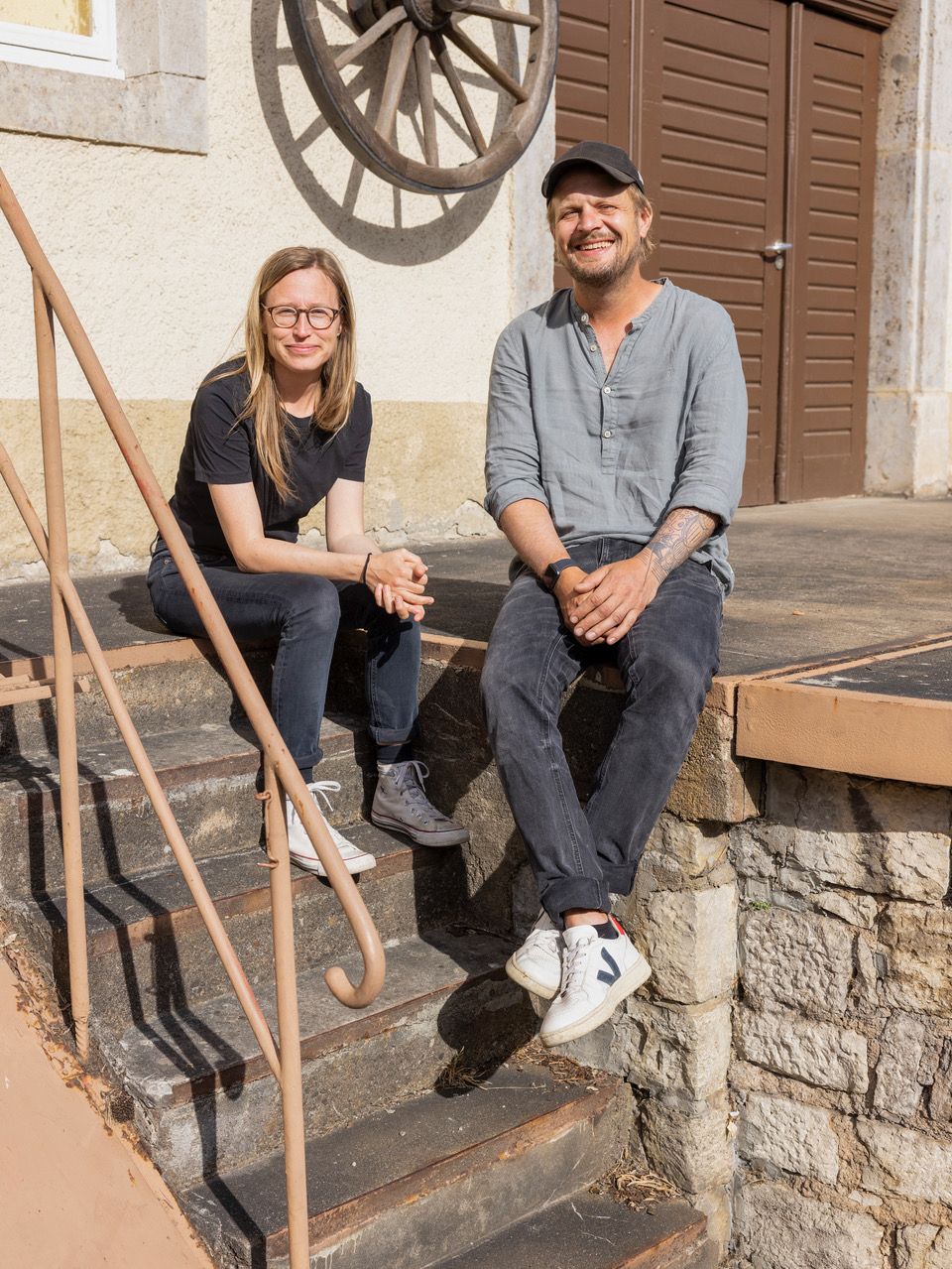
Can you tell me about your background - what led you to become winemakers and when and why did you decide to start the winery together?
The winery is roughly 180 years old. It’s an old family winery that was very traditional and conventional before my time. I wasn’t interested in wine at all - it all tasted pretty much the same to me. My parents never encouraged me to continue the business, they actually suggested I think about something else as it wasn’t doing so well. It was pretty big in the 1960s with 40 or so people working here, but it was all built around selling the grapes and that business model wasn’t working that well anymore.
I studied philosophy and, as is often the case when you study something like that, I ended up working in media. I worked for the German edition of Scientific American, where I met Melanie - who has a background in Jewish studies, so neither of us started out in wine. Together, we ended up in London, working for Nature Publishing Group, one of biggest science publishers in the world, in around 2011 when natural wine was just starting in London and when the first RAW WINE took place.
Really very randomly, we started getting a bit more into wine. We lived in Archway and there was a cute little wine shop there. When we were walking home one night, the sales guy asked if we were feeling adventurous, and of course the answer to that question is always yes. They gave us a bottle and it was Pascal Simonutti’s Boire Tue, a reductive red that first puzzled us and second blew us away. We didn’t know why it tasted so different, or even if there was a category this wine fell into. We started digging, trying more wine and going to these events that started popping up where you could learn about wine.
So we discovered natural wine from there and a couple months after, my father called me and said that he needed to start making his plans for retirement and selling the winery. We realized that, in Germany, there was pretty much nothing happening yet except the first vintages of Rudolph Trossen and Stefan Vetter. With a mix of a pioneer spirit and a desire to both keep that old place alive and do something for ourselves rather than working for another billionaire, we decided to quit our jobs and moved back here in 2013. The same year, our first child was born and we made our first 2 small batches of wine from a couple vineyards of around 4 hectares.
I didn’t really know what I was doing, but my dad had a cellar master employed at the time who made his wine and farmed the vineyards, and that was the very beginning of what we do now. With the 2015 vintage, it was clear to us that this might actually work financially. I learned all the technical basics from the cellar master, and they then retired around the same time as my parents. We faded out the old business and downsized the old winery, which has a cellar capacity of around half a million liters, but now we make 40,000 liters.
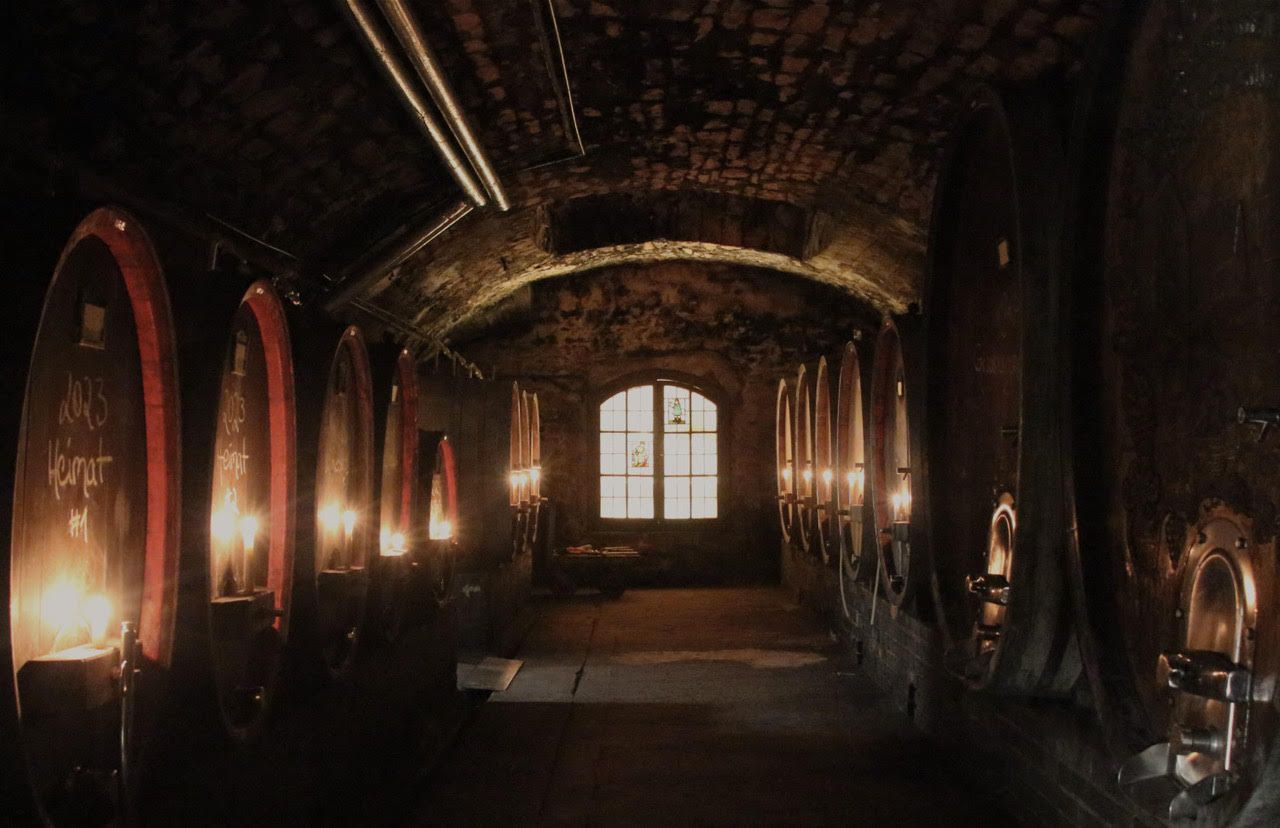
Where did the name 2NaturKinder come from?
The winery had my family name before me, and is still the legal name of the winery. But it was pretty clear from the beginning that the wine I was making was so categorically different from the rest of the wine, that it would be confusing to have the same name on the bottle. As soon as we had given notice to the company we were working for at the time, we started writing a blog about the whole journey. 2NaturKinder was name of the blog - it means 2 children of nature - so we just went with that, and now we’re kind of stuck with it!
Can you tell me about Franken, and the grapes, climate and traditions that define the region?
Franken isn’t huge. It has roughly 6,000 hectares of vines, so is a little bigger than Chablis - the big toe of Burgundy. But compared to France, everything is very small here. All of Germany is maybe the size of Bordeaux. The bedrock soil types are sandstone, limestone and keuper. Where we are, right in the middle of the region, it’s limestone, some older and some younger. It’s one of the driest regions in Germany, and warmer than others due to climate change. The summers are getting hotter and hotter with less rain, and more rain in winter. For some aspects of winemaking like planting a new vineyard or making big yields, this isn’t a very big advantage. But for wine quality, it’s not bad at all. There’s one variety that stands out in the region, and that’s Sylvaner, followed by not much else to be honest. It’s the main variety of the area.
What's the natural wine scene like now, and how does that differ from when you started out?
From a producer’s perspective, there was a small scene back when I first started. But from a market perspective, there was nothing - it was purely an export business for us. Quite frankly, the first RAW WINE we attended in 2014 was a huge help for us. We went there, came back, and all our wine had sold out. The natural wine scene grew very slowly after that and it was 4-5 years ago that the market started growing a lot more. The cities first, and now smaller towns.
There are quite a few young producers, which is absolutely wonderful, and they start with a lot of the idealism that motivates producers. But there’s a lot of conventional producers who do natural wine alongside their other portfolio, which is very convenient. I remember that when I was first working alongside my old cellar master, if a batch messed up, you could filter it and use it for a conventional blend. That’s where it’s become a little blurry here, with producers just dipping their toes into natural wine.
While there are not many zero zero producers here, it’s definitely grown. I think the next couple of years are going to be very exciting to see unfold. At first, it was almost impossible to get a profile of the country, but now there’s more natural producers, we can start to see differences between the regions. And that’s where it gets interesting from a sommelier perspective.

Can you describe the vineyard and its surroundings?
We have 7.5 hectares and It’s not one big plot, but most of the vineyards are quite close together and reachable by bike. They’re also quite close to the town and sit on 2 small hills. Most of them don’t have neighboring vineyards though, which is nice, they’re surrounded by hedges and trees. If there’s not enough trees, we plant more. 3 years ago we planted a hectare of vines and I found it incredibly depressing to walk through rows and rows of the same thing. We broke it up with 2 huge piles of dead wood that could rot there and provide a home for animals. It also gives you the chance to, instead of starting in row 7 and ending up in row 9, starting at a particular tree and ending at a dead pile of wood where you saw a snake 3 weeks ago. We spend most of our lives in the vineyards, so they should be a joyful place to work in. That’s why we do little things like that to break up bigger plots. It also has an impact on the yeast flora, the grapes, and the stability of the ecosystem.
What grapes go you grow?
A lot! Ha. Our set up wasn’t created from a drawing board. We inherited what we inherited and we started renting other land. We also planted a lot of field blends, so including these, we’ve got somewhere between 25 to 30 varieties. Sylvaner is the most important for us, and it gets on well with climate change and droughts. We also have a bunch of different Pinots that do quite well, and we have a lot of Muller-Thurgau, the bread and butter variety of the country, or central Europe.
Which grapes have you used for this wine?
It’s a blend of 3 varieties - Muller-Thurgau is the biggest and comes from 1 vineyard and goes into 1 big barrel. Then we have a smaller barrel of Sylvaner and an even smaller barrel of Riesling. The ratio is roughly 4:2:1.
Can you talk me through the process of making this wine?
This is one of the very few white wines we have that’s direct pressed. We start picking at the end of August and beginning of September, depending on the year. Muller-Thurgau is always early September, Riesling last at the end of September and Sylvaner somewhere in the middle. Usually we stomp the grapes, then we throw them in the press or transport them in the press with a conveyer band - also known as a giraffe or dinosaur depending on the continent you come from. For this wine, the Sylvaner went into stainless steel and the Riesling and the Muller-Thurgau went into Franconia oak. If nothing suspicious is going on, I leave the wine until the following summer. We’re now at a point where we keep everything for at least 14 months, but this wine was 10 months. Then it was racked, blended and bottled in August 2022.
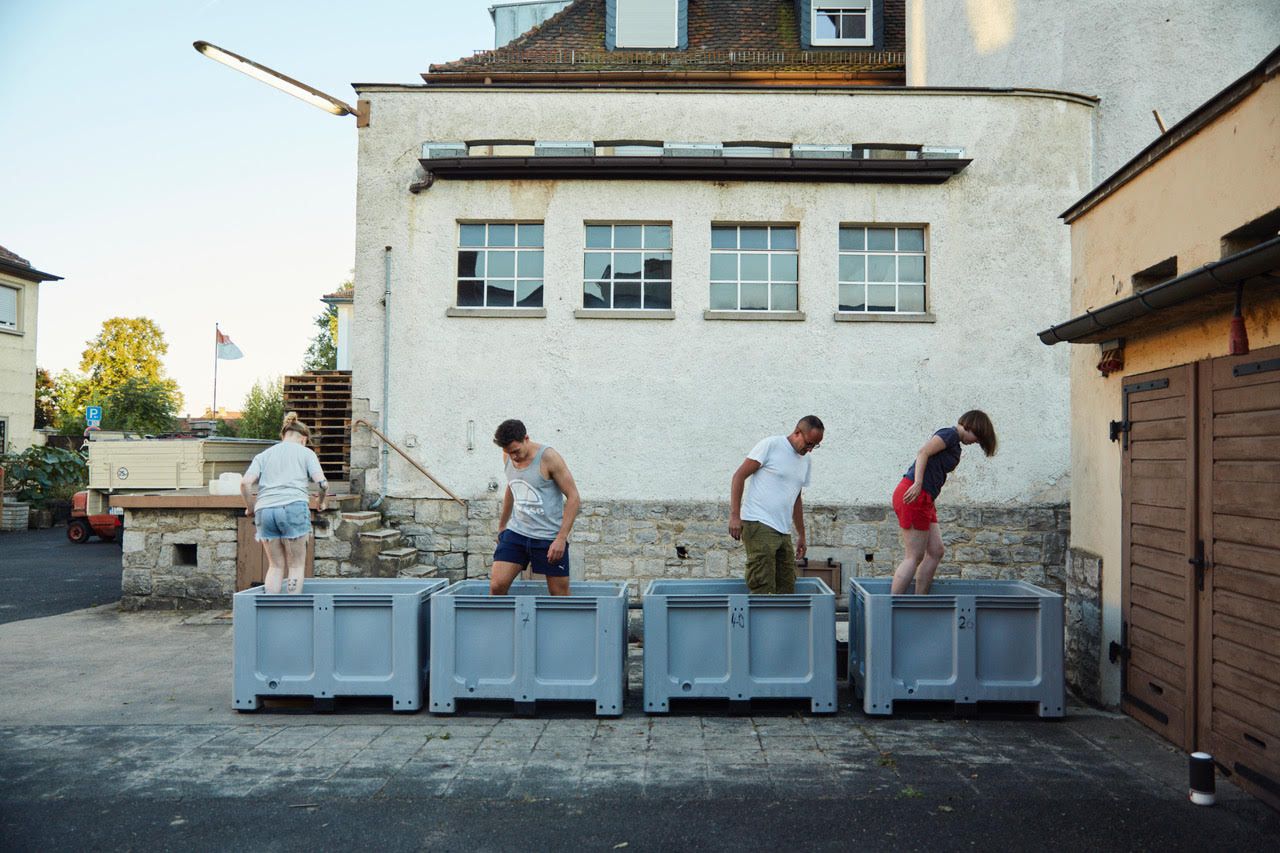
Do you use any sulfites and what are the total sulfites per liter?
No we don't add any sulfites, but based on analysis, it contains 6mg of naturally occurring sulfites per liter.
How would you describe the wine?
It’s a wine that - as many of our wines do - has a certain herbaciousness to it, and a very citric level of acidity. It has a good grip.
How does this vintage compare to others?
Since 2018, it’s been fairly consistent. It’s not crazy different between vintages. 2021 was a very difficult year for us - we had huge issues with downy mildew and lost a lot of grapes. But it was a nice vintage and fairly representative of what this blend is across the years.
When is it best enjoyed? Now or later, if people want to age it further in the bottle?
I would drink this now. You can keep it for a little longer, but Muller-Thurgau is not really a variety you want to age for 20 years.
What’s the story behind the name of the wine, Fledermaus?
It’s the German word for bat. When we first made this wine, we had fewer vineyards and took over the lease on a vineyard in the middle of town. There’s actually a documentary on the vineyard on YouTube by Panco Vino, they do some really cool portraits of other winemakers. But it’s a really interesting vineyard. It used to be on the outskirts of town, but the town grew around it. It’s a 1.2 hectare habitat surrounded by houses and gardens. It’s where the hill starts. It’s a quirky, weird place, because you can’t see the vineyard from almost anywhere in the town. Most people don’t know it exists. But you can see a petrol station and McDonalds from inside the vineyard. A friend of mine who was very much into bats said he thought it could be a habitat for bats, so he monitored it for a few months and observed 15 different species in the area. This allowed me to access bat dung and use it for a potent fertilizer and to of course give money back to the bat community. We’ve built a couple of things like bat boxes to help them thrive, and sewed plants to attract moths for them to eat.
Any food pairings you’d recommend?
I actually have a really nice food memory with this wine. One of the most beautiful pairings I’ve experienced with this wine was when Yana Volfson had it as a pairing for Mexican food at Cosme in New York. That was amazing. I think it’s the citrussy acidity in the wine, it behaves a little like the lime that you would squeeze over Mexican food. I’ve seen it paired with pizza as well.
Isabelle's thoughts on Fledermaus - A lovely, fresh, easy drinking white with lots of primary fruit notes - crunchy, white nectarine, green mango, and crisp, zesty limequats. A touch of spice (celery salts and curcuma root) brings balancing earthy notes to what is otherwise a fruity, upfront blend.
TOTAL SULFITES: 6mg/L
Testalonga, Keep on Punching, Swartland, South Africa, 2022
Testalonga is a winery in South Africa's Swartland region, run by Craig and Carla Hawkins since 2008. If you're an OG RAW WINE Club member, you may remember trying Testalonga's Stay Brave as part of the selection in October 2022 - check out his interview for that here.
Q&A with Craig Hawkins
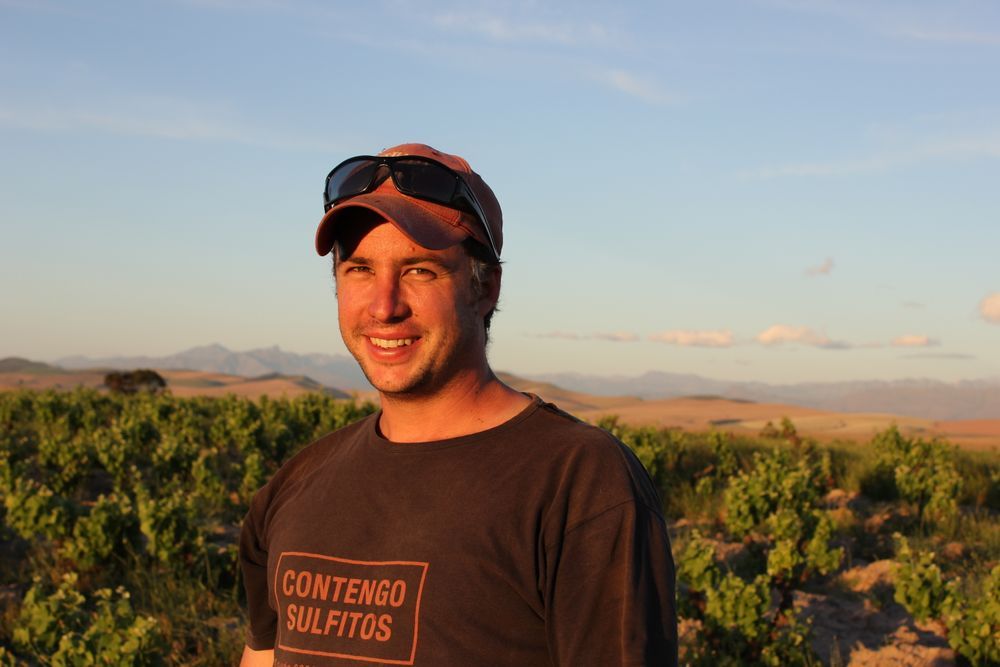
We last spoke in October 2022. Have you made any changes to the way you work, or introduced any new cuvees in that time?
Not in terms of the way we work, but we've introduced a new wine - the first Grenache Blanc from our Bandits Kloof farm, called Daisy's Pond.
For those of our members not yet familiar with your wines, can you tell me about your background - how you came to be a winemaker, and what has influenced your style of farming and producing?
I'm originally from the east of South Africa and not from a winemaking background. My older brother got into wine when we moved down to the Western Cape. He's 5 years older and got into wine in late 90s, so I learned from him. I used to work for him during the holidays and that's how I fell in love with it. I had always loved the outdoors and, working in the vineyards, I saw the movement from vineyard to cellar and my interest in art tied in with the wine labels. My brother was a big influence in that sense. In terms of farming and producing, I get influenced all the time, but I'd say the key people for me were Eben Sardie, Tom Lubbe, Dirk Niepoort and Remi Pedreino. Those are the guys I worked for and who influenced me heavily.
I was always organically inclined - how I got there, I couldn't really say. But working for lots of different people helped me realise you can make wine that way too. Pascal Schildt also had a big influence on me because he made the first natural wine I ever tried in 2007. From these influences, as we move forward, we refine our style and make something that's our own. It's finding a balance between vineyard, cellar and our own style. And for our white wines we've certainly found that style - salty and acidic. Every year we improve and get more focus into the wines.
Can you tell me about Swartland, and the grapes, climate and traditions that define the region?
I would say the defining feature is that it's quite expansive. There's a lot of space and a lot of wheat fields. It's very dry, particularly in summer. We have a Mediterranean climate with cool wet winters and dry hot summers. It's quite, I wouldn't say extreme, but it does have its extremes. It's dotted with big mountain ranges where all the winemakers and wine farms are - the slopes are where you get the quality.
People have made their names with old vine Chenin Blanc, but a lot of people are now planting more vines, so in 10-20 years there will be a big transition in terms of the grapes we have in the region. We'll see more Carignan, Grenache, Mourvèdre, Vermentino, Assyrtiko, Macabeo, Grenache Blanc and Grenache Gris. The kind of grapes you find along the Italian, French and Spanish coast lines. Of course we have Cabernet and Shiraz, but that's where the region is going. We have the ocean to our left and the oceanic climate is why we can make the wines we do.
Is there much of a natural wine scene there?
Yeah definitely, there are quite a few producers working in this way - 5-6 guys focussing on that style which is nice. But it's a big region so I suppose it's not that much.
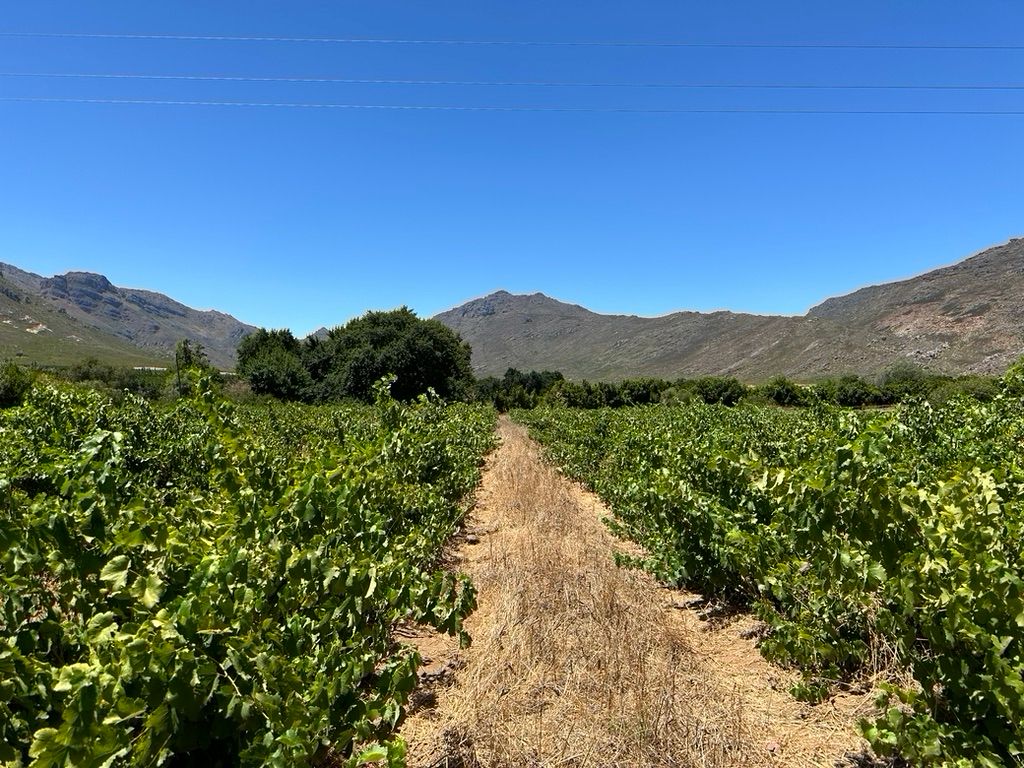
Can you describe the vineyard and its surroundings?
We have 6 hectares of our own vines, but we also buy from old vineyards. For Keep On Punching, we buy from a vineyard that was planted in 1961. It's surrounded by table mountain sandstone, that's the soil group. It's 35km from the ocean, in a valley where the mountains meet at 150m above sea level, but the mountains go up to 950m altitude. It's surrounded by nature with some citrus farms, rooibos tea and wild vegetation on the mountain slopes. There's not many clouds. It gets quite cool in the valley which helps us get the acidity.
What grapes do you grow and how many hectares do you work with?
We work with quite a few different varieties. As well as the 6 hectares that I farm myself, I rent another 18. They include Chenin, Carignan, Grenache, Mourvèdre, Macabeo, Tinta Amarela, Cinsault, Shiraz, Colombard, Muscat Alexandria - there's a lot.
Which grapes have you used for this wine?
This is 100% Chenin Blanc.
Can you talk me through the process of making this wine?
This vineyard is organically farmed and generally quite low yielding. We harvest on taste - that's how I feel comfortable. When I feel the acid is in balance, usually around 12-12.5% acidity in late January. We pick in small 15kg crates and we take the grapes to a cold room that we have on the farm so they can cool down from 20-25 degrees down to 6 the next morning. I whole bunch press and separate it out into a batch of different juices. Each juice goes into oak barrels and stainless steel, usually a 60/40 split. They ferments in their on lees for around 6 months. Then towards the end of the year, I taste them and blend the best of the batch with a little sulfur, and return it to wood and steel for 11 months of ageing. Then we bottle.
What are the total sulfites per liter?
30mg/L.
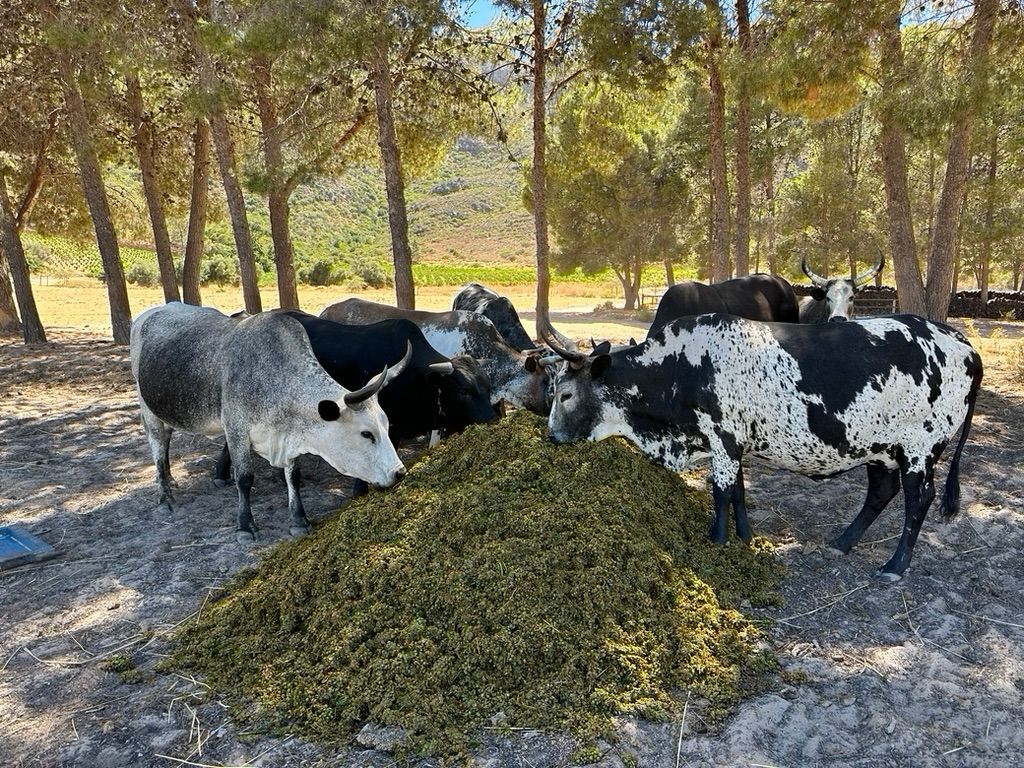
How would you describe the wine?
This wine, typically of Testalonga, has a salinity that I like. It makes you salivate and that comes from the acidity. It's very linear and salty, with a good bunch of fruit sweetness as well. It's quite dry overall, but very moreish to me.
When is it best enjoyed? Now or later, if people want to age it further in the bottle?
Baby Bandito is a series that we make for people to enjoy by the glass and this vineyard lends itself to that. It can be drunk young, but the first vintage was 2015 and it's still perfect. Generally, after a year is around when it really opens up. You can drink it straight from bottling, though.
What’s the story behind the name of the wine, Keep on Punching?
Keep on Punching is an English expression to say keep on keeping on. Baby Bandito the series is all about being positive. I played a lot of sport at college and this one guy always used to say to me, 'Keep on punching'. So it means - follow your dreams, stay brave and keep on punching.
Any food pairings you’d recommend?
Because of the acidity, it generally works well with anything slightly oily or fatty, so there's a lot of food you can pair it with. Any kind of small plate with olive oil or vinegar, or something fatty like pork or fish with a little spice.
Isabelle's thoughts on Keep On Punching - Another Chenin by Craig! But the extended time on its lees has given this particular bottle extra texture and weight, while retaining Craig’s usual stylistic crunch. Cooked quince, beeswax, mirabelle plum, some cinnamon notes and fragrant linden flowers - this is a very pretty wine that packs a punch.
TOTAL SULFITES: 30mg/L
Bodegas Coruña del Conde, I Am Natural Don't Panic, Orange, Castilla y León, Spain, 2021
Bodegas Coruña del Conde is a family winery in Castilla y León's Burgos province, run by Julien Ben Hamou Lopez. It was founded by his grandfather in 1990 and is made up of 29 small plots of land with a total surface area of 8 hectares, all sitting at a high altitude of 1,000m above sea level.
Q&A with Julien Ben Hamou Lopez
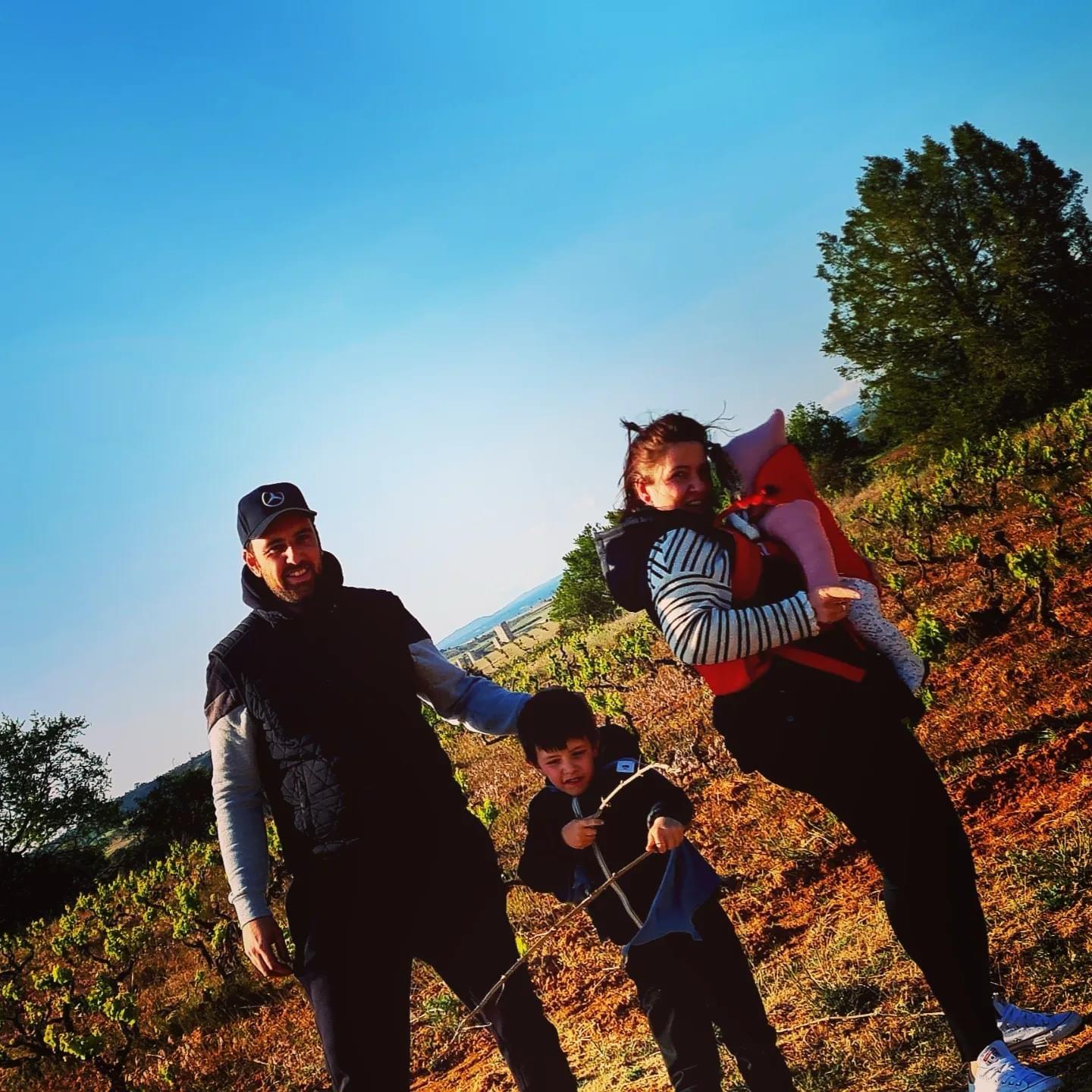
Can you tell me about your background - how you came to be a winemaker, and what has influenced your style of farming and producing?
I'll tell you my story. It all started with my grandfather, Alberto Lopez Calvo. He worked in Bordeaux for 30 years and came back to the village to make the wine of the land where he was born. He was the first man who presented natural wine in this region, making only 10,000 bottles per year. He planted 3.5 hectares of vines in the 1970s and started the a winery in the 1990s. In 2012, my grandfather died and this little winery was a big economic problem. I'm from Montpelier - my father is Moroccan and my mother is Spanish, from Coruña del Conde.
I was working in streetwear before and a few months after my grandfather died, I decided to change my life, come back to my mum's village and buy my winery. Now, I work 8 hectares with my wife, across 29 plots. We do it all together. The vines now range from 8 to 135 years old and we make around 25,000 bottles a year. I was making a lot of different ranges of wine, but this year I decided to simplify and now just stick to 4 ranges: Alberto Lopez Calvo, Alto Otero, BC/DC and I'm Natural Don't Panic. And each range has its own wines.
Can you tell me about Burgos, and the grapes, climate and traditions that define the region?
My village is very little, with a population of 80 people, and sitting at 1000m in altitude. We're in the Castilla y Léon region, between Madrid and Bilbao. It's typically cold in winter and around 40 degrees in summer, which drops down to 10-12 at night. Because of the climate, the maturation of my grapes is longer, so I start my harvest late around mid October and finish in mid November. All the land is clay soil and I work with 16 different grapes, but mainly Tempranillo. The typical gastronomy of area is lamb and black pudding with rice.
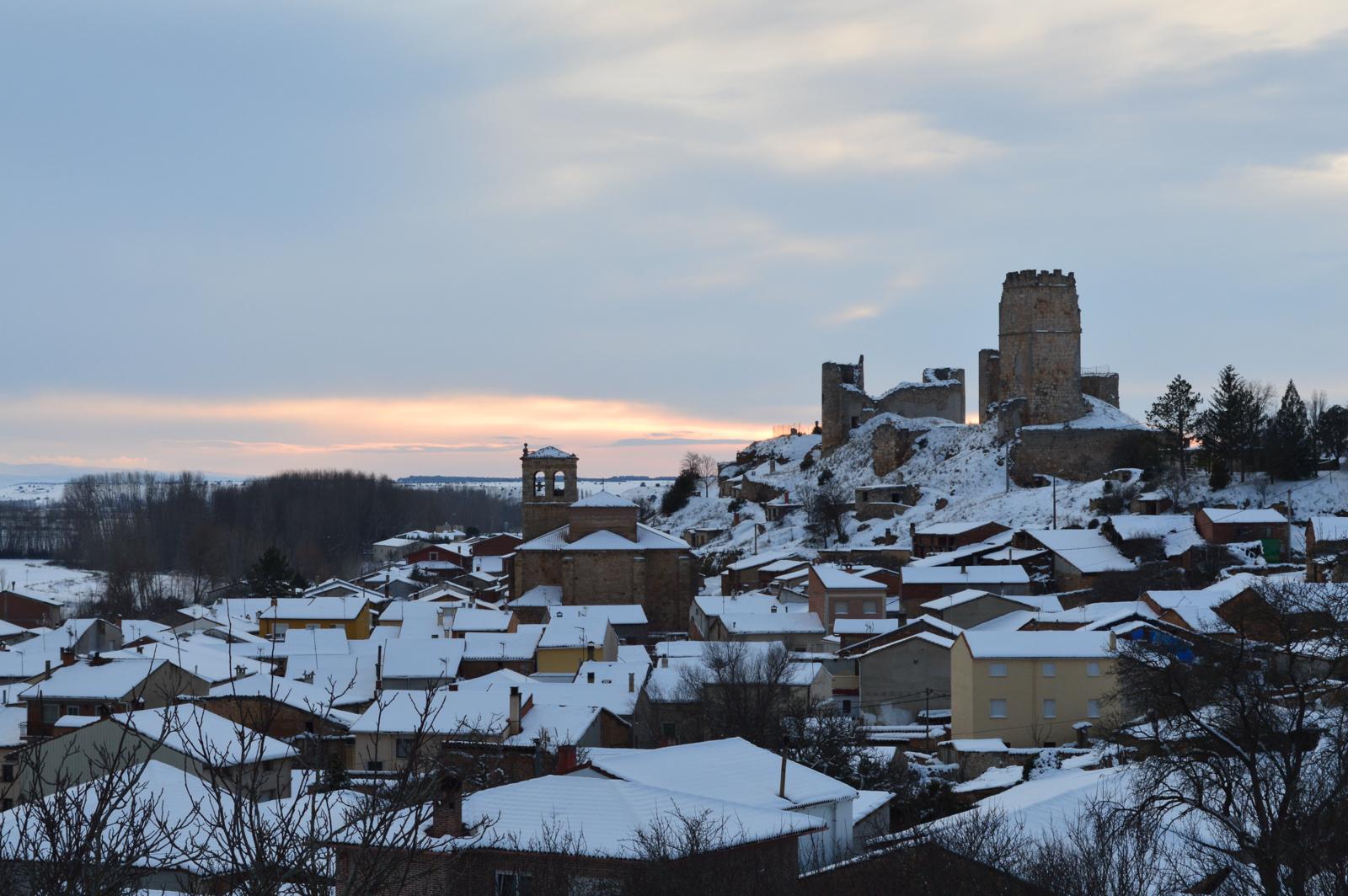
Is there much of a natural wine scene there?
No, this is the problem. The closest city is 35km and there are no natural makers nearby. But in Ribera del Duero, there are my good friends Alfredo Maestro and Goyo García.
Can you describe the vineyard and its surroundings?
For the newer vines, I have Tempranillo but also French grapes like Merlot, Cabernet Sauvignon, Pinot Blanc, Pinot Noir and Malbec, etc. And for old vines, we have many little plots of grapes such as Albillo, Garnacha and Garnacha Blanco. 29 little plots all in Coruña del Conde, from 115 to 1080m in altitude. I work naturally with my vines, never using pesticides or chemicals. My grandfather was the first to work in this way and I continue his legacy.
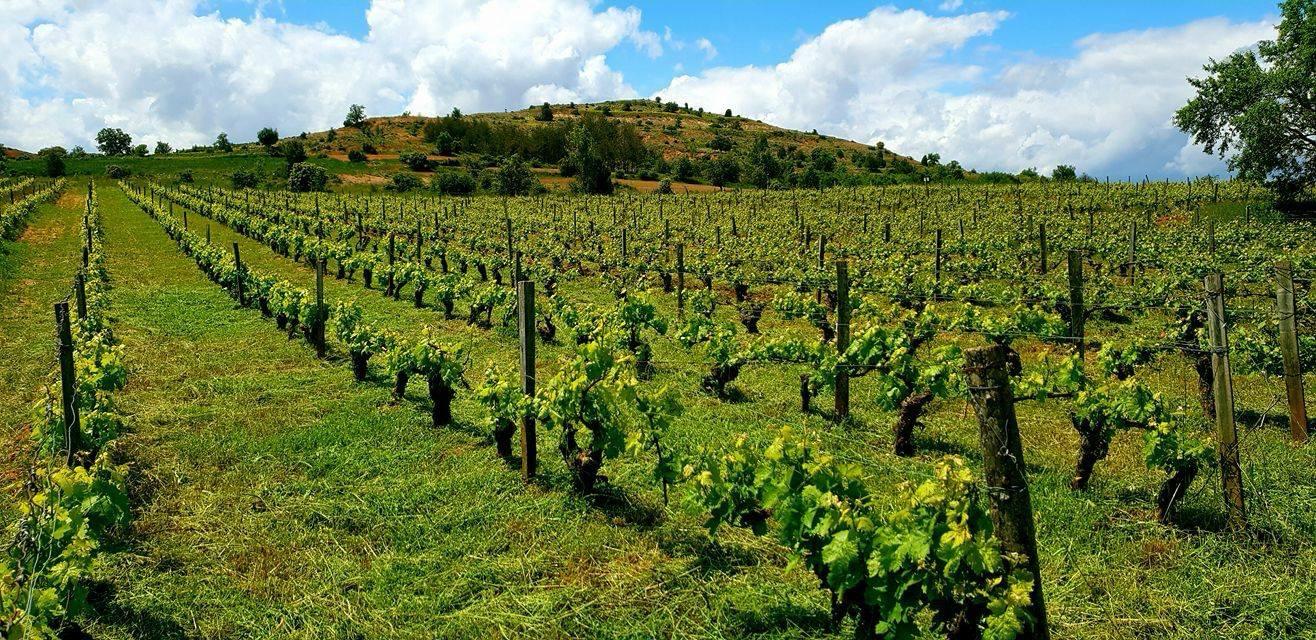
What are the unique challenges of working across multiple small plots of land at such a high altitude?
Challenges? No, I'm very lucky. I'm here because this land is my mother's and my grandfather's, but the altitude is lucky because it gives the wine very good acidity with tannins and alcohol. My wine is fresh. Sometimes we have problems with frost - like in 2017 and 2021 when I lost all or some of my harvest - but mostly it's lucky. The altitude helps make it easier to deal with climate change as well. The continental climate is better for viticulture, much easier.
Which grapes have you used for this wine?
I bought these grapes from my friend, after losing mine. These are from Domaine Brand in Alsace and are 70% Riesling, 10% Pinot Blanc, 10% Chardonnay, 5% Sylvaner and 5% Gewürztraminer. He sent me the grapes and I make the wine in my home, in the winery.
What's the process of making this wine?
I stomp the grapes and they get 2 months skin contact, then 1 year in stainless steel and 1 year in the bottle before I sell. This wine is now sold out.
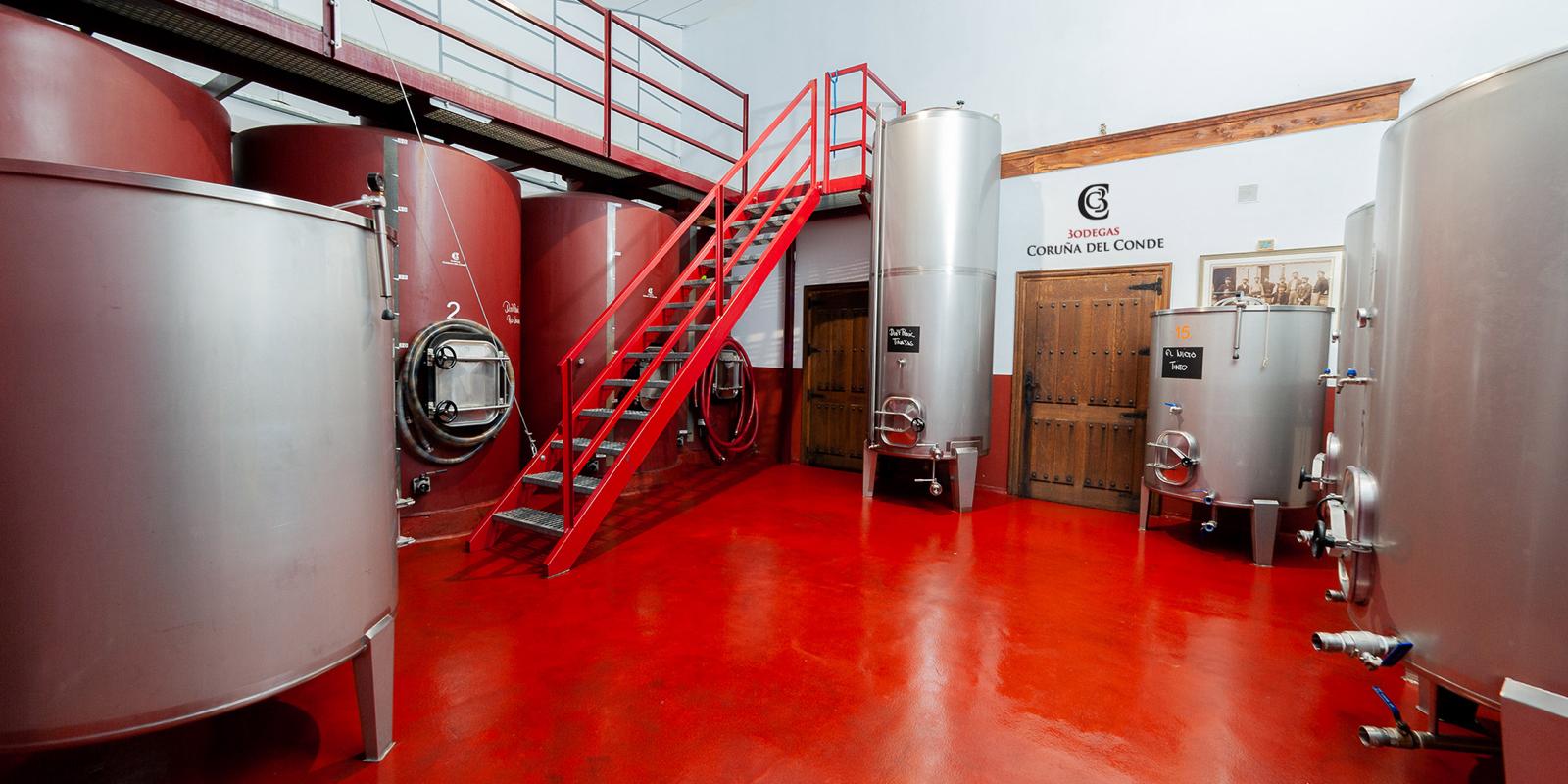
Do you use any sulfites and what are the total sulfites per liter?
No, I never use sulfites. In making wine, I think understanding 3 things is very important: alcohol, acidity and tannins. These are the things you need to understand to make good wine. In terms of naturally occurring sulfites, it's less than 8mg/L.
How would you describe the wine?
It's very complex - mulch in the nose and in the mouth, a very long wine and very gastronomic.
When is it best enjoyed? Now or later, if people want to age it further in the bottle?
It's nice now, but possible to keep this wine if people want to.
Any food pairings you’d recommend?
It's nice with foie gras, calamari, cheese and fried chicken.
Isabelle's thoughts on I Am Natural Don't Panic - This luminous, deep orange medley of grapes, saw 60 days of skin-contact which has resulted in an abundance of spice (cumin, curry leaf), bergamot notes and apricots, which are all framed inside lovely tannins that bring earthiness and sobriety to the blend.
TOTAL SULFITES: <8mg/L.
FUN FACT - This Castilian wine with a French twist was made using grapes sourced from the Alsatian Domaine Brand (see Julien’s interview above to find out more), which also happens to be the very same place SOMA WINES sourced their grapes for Crossing Borders. Taste the two bottles side by side - can you taste a similarity of terroir and grape grower?
Dominique Derain, Nubes, Casablanca Valley, Chile, 2020
Dominique Derain is a winemaker well known in the Hautes Côtes de Beaune, who handed his Bourgogne winery over to Julien Altaber and Carole Ruffenach. Since then, Dominique has received requests from winemakers all over the world to vinify wines for them. He met Chilean winemaker Julio Donoso of Montsecano, who suggested Dominique come to Chile and make some wines there. This wine is a result of that partnership.
Q&A with Dominique Derain
Can you tell me about your background - starting with Domaine Derain and your initial foray into the world of wine?
I have always wanted to make wine, and I live my dream every day. I started working in biodynamics 40 years ago, as a pioneer in the domaine I created. I didn't learn languages and I didn't go to school for long because I got bored there. My grandparents instilled in me this love of vines. I am self-taught and make wine surrounded by young people, so am passing down my passion. I don't see myself getting old, so I am happy to share my knowledge and adapt to the projects that are proposed to me today, regardless of the region, country, etc.
I'm more of an artist - I'm in love with poetry, with shows and the arts in general. It's this that interested me very early on and also led me away from the life that was imposed on me. I always wanted to remain free in my actions. Making wine allows me to remain a free spirit.
Sharing, writing and loving others drive me every day, and allow me to get straight to the point.
At what point did you know that it was time to step away from the Domaine, and what drove that decision?
This distancing is the result of a psychological and physical injury. It took time to take my distance, to decide to stop and leave this adventure behind that I had embarked on.
Now I'm at peace with myself and my happiness is to visit rare domaines and to help them produce gems. I'm there when they need me and that's what matters to me today. I try to be there at the right time and to do beautiful things, sometimes daring things, and often they work, which is wonderful!
My purpose is and always will be to bring wines into the world naturally.
How did this Chilean collaboration come about?
This project arose from a request by Julio Donoso who at 18 years old, was extradited from prison with his mother during the time of Augusto Pinochet [Chile's head of state from 1973 to 1990] to go to the USA.
He became a great photographer in the USA and in Paris, and he came to the Domaine one day while I was officially retired. He proposed that I come to Chile to make wine, and I went there in 2018 to make the first vintage. I stayed there for the vinification and then visited the northern part of the country.
In the following years, I returned for the vinification until 2020.
Arthur, our friend from San Pedro de Atacama whom I met in the northern part of the country and whom I sponsor, is taking care of it now.
Do you plan to make more wines in Chile, or is this a one-off project?
It was a one-time project that came out of friendship. Today, I continue to go where I am needed. Very soon, I will probably settle in the Piedmont, in the Alpes Maritimes. I am also currently making wine in the Pyrénées Orientales and in the Loire.
Can you tell me about Casablanca Valley, and the grapes, climate and traditions that define the region?
The wine traditions in the Casablanca region are about 30 years old. The influence is oceanic. It's a valley between two ranges of small mountains with water intelligently rationed by the country, which allows for irrigation if necessary.
Oenologists make the wine here, unlike in the south or north where there are real farmers making natural wine. Las Nubes is a beautifully exposed estate, located in the locality of the same name, on a volcanic terroir that produces wines of 13 degrees which is quite exceptional for the region! We met with the winemaker who agreed to sell grapes to Julio. We harvested them so that I could make my cuvée in Julio's cellar while I was vinifying his wines.
Is there much of a natural wine scene there?
Yes, but it is mainly large estates that Europeans set up about forty years ago. You don't find the old vines that came with the Spaniards here. So this region has nothing to do with the south or north of the country.
What have you observed to be the key differences between Chile and Bourgogne in terms of wine growing and making?
The main differences are that there is no phylloxera in Chile and there is no need to graft. That's a big advantage! The other difference, which unfortunately is being erased, is the climate. The altitude is quite similar, but Chile has more freshness due to the oceanic influence. The morning mist is there and brings a bit of humidity. The pruning methods are similar and often in 'guyot,' but the difference in Chile is that they are a bit taller (1m) and wider. The other thing is that it is irrigated everywhere in the area to help with growth, in the beginning as well as three weeks before harvest. They don't have mildew problems or very few, so the vines are rarely sick or treated.
Can you describe the vineyard you work from and its surroundings?
It's a small and beautiful vineyard where the vines are tended by a passionate farmer. It is north-facing, in a hollow valley which allows for beautiful grapes at 13 degrees, which is what I was looking for. The place is very inspiring, peaceful, with a small, very artisanal cellar that I really like.
What grapes go you grow and how many hectares do you work with?
I worked exclusively on Pinot Noir in Chile, but other grape varieties are also planted. The entire estate covers about thirty hectares, a micro estate in this area.
Can you describe the soil and the terroir?
It is a volcanic terroir that I hadn't come across in Burgundy and which allows for a beautiful expression of Pinot. It spices up the result a little.
Can you talk me through the process of making this wine?
At harvesting, grapes are picked in the morning, the first truck arrives at 10am. Grapes picked late morning often stay outside overnight to benefit from the coolness, which allows us to reach 9 degrees on all grapes when put into the vat. If it ferments well, it's okay. If it doesn't ferment well, we add warmer grapes.
For all the cuvées, we use a portion of whole bunches and a portion destemmed (the proportions vary depending on the mood of the winemaker, and by eye too). For La Nubes, I did a bleeding - a drawing made the next day to make it a little pink - this went into an egg-shaped concrete vat and fermented like a white.
Alcoholic fermentation lasted 7 to 10 days. Before the end of fermentation, we drew the wine from the vat, pressed the grapes and combine everything: the press, the free-run wine and the bleeding. At the press, the whole bunches of grapes allowed us to increase the density, which helps to restart fermentation thanks to oxygen.
Malolactic fermentation lasted a month, then we racked to remove the lees and left for 4 or 5 months before bottling, which usually takes place after Easter.
All this results in elegant wines with greater drinkability.
Do you use any sulfites and what are the total sulfites per liter?
I don't add anything.
How would you describe the wine?
It is a teasing wine, which does not always correspond to what one expects from a Chilean. It is delicate in color and it is highly drinkable but with character. It is rich without being heavy.
How does this vintage compare to others?
I released four vintages - 2017, 2018, 2019 and 2020. There is a certain consistency in the quality of the grapes due to the climate. What has changed is that the first ones were more like a Gamay than a Pinot. By reconsidering and adjusting the winemaking, we returned to Pinot and its characteristics.
When is it best enjoyed? Now or later, if people want to age it further in the bottle?
It is perfect for now, but it will probably also drink well in 10, 30, 60 or 80 years. Just like the wines of my ancestors or the wines from my beginnings!
Any food pairings you’d recommend?
It pairs perfectly with white meat, vegetable stew, cheese, friends and girlfriends!
Isabelle's thoughts on Nubes - Ethereal, fragrant, pretty and almost translucent in color, this Pinot Noir is surprisingly powerful. Clearly Chilean in ripeness, with notes that suggest plenty of light, it is also elegant and earthy with a great precision of aromas and texture. Long, fragrant and incredibly pure, this is a charming Burgundy-with-sunshine. Derain is a phenomenal winemaker, and it is a genuine treat to be drinking the last edition in his Chilean series.
TOTAL SULFITES: <10mg/L
Autour de L'Anne, Anne A Wine Again, Languedoc, France, 2020
Autour de L'Anne is a winery run by former industrial professional Anne Paillet, who left her career in 2010 after a serious car accident led her to re-evaluate her life's path. Friend of Anne and biodynamic winemaker Christophe Beau offered her partnership on his 6 hectare estate in Coteaux du Languedoc, renting her 2.5 hectares to use as her own. In 2011, Autour de L'Anne was born.
Q&A with Anne Paillet
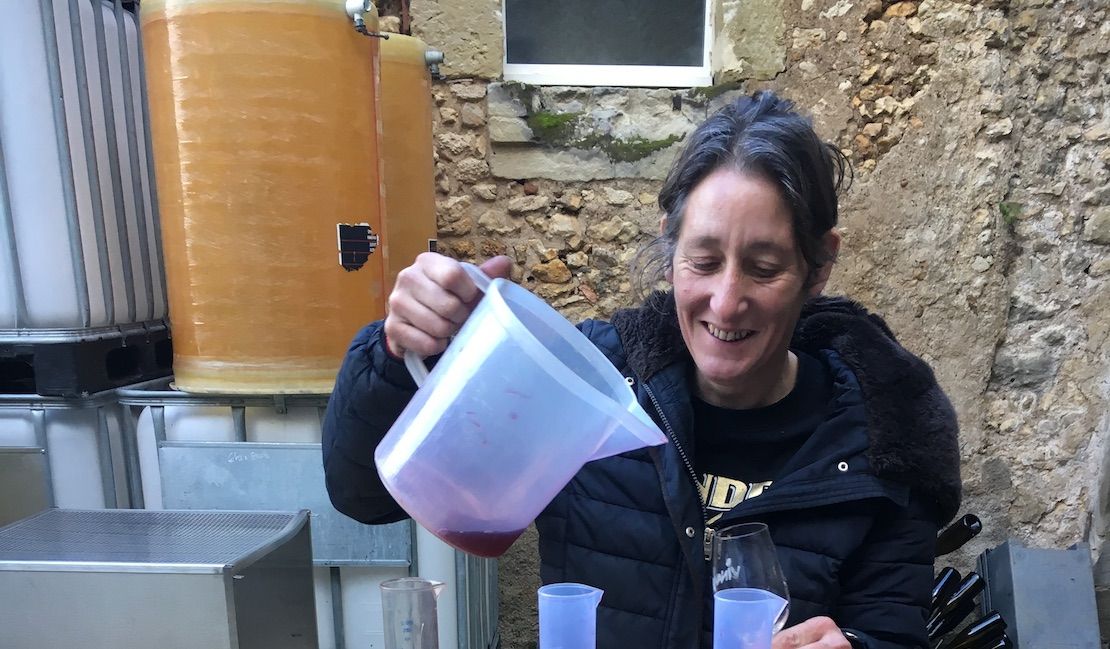
Can you tell me about your background - the career you pursued before coming to be a winemaker, and what instigated this career change?
Before I started making wine, I was a purchasing manager for a big company in transport and logistics. I had a bad car crash in 2005, so I stayed away from work for around a year. During that time, there was a natural wine shop that opened on the road I was living on in Paris, and they did winemaker tastings. That's when I started drinking natural wine and I found it really interesting, meeting the winemakers and hearing about how they worked.
After the accident, I wanted to change careers. I grew up in a small village in Saint Marcel Bel Accueil, in the Isère department of southeastern France, then moved to Nuits St Georges in Burgundy as a teenager and I worked at a vineyard. I had this experience from when I was young and I wanted something through which I could connect with nature and express myself better than I could with purchasing.
What was it that made you want to start your own estate, and how did Autour de L'Anne come to be?
I wanted to make wine, but I couldn't go back to Burgundy because it was too expensive and I had no money. I became good friends with a winemaker Christophe Beau from the Languedoc and he said that I could visit every now and then and work with him in the vineyard and winery, so that I could learn from him how it all works. Eventually, I decided to move to the Languedoc to be nearer to the winery and continue my learning.
In the meantime, I met my husband - a winemaker in the Loire - so it became a little complicated to figure it all out! Christophe offered to sell me his grapes to make wine, which I did from 2011 to 2018, then he retired and passed all the vines to his son. However, he connected me with a farmer friend of his, who grows grapes, asparagus, tomatoes and pumpkins, and that's who I buy grapes from now. Those are the only grapes I've worked with since 2018.
Another friend of mine, Kevin Blackwell, was running a restaurant in Paris called Autour d'un Verre. He said to me that he thought I would have a winery one day and that I should call it Autour de l'Anne. Autour d'un Verre means around the glass and of course Autour de l'Anne means around Anne. Because I was helped by Christophe, my husband and a lot of friends who were around me, it felt like the perfect name.
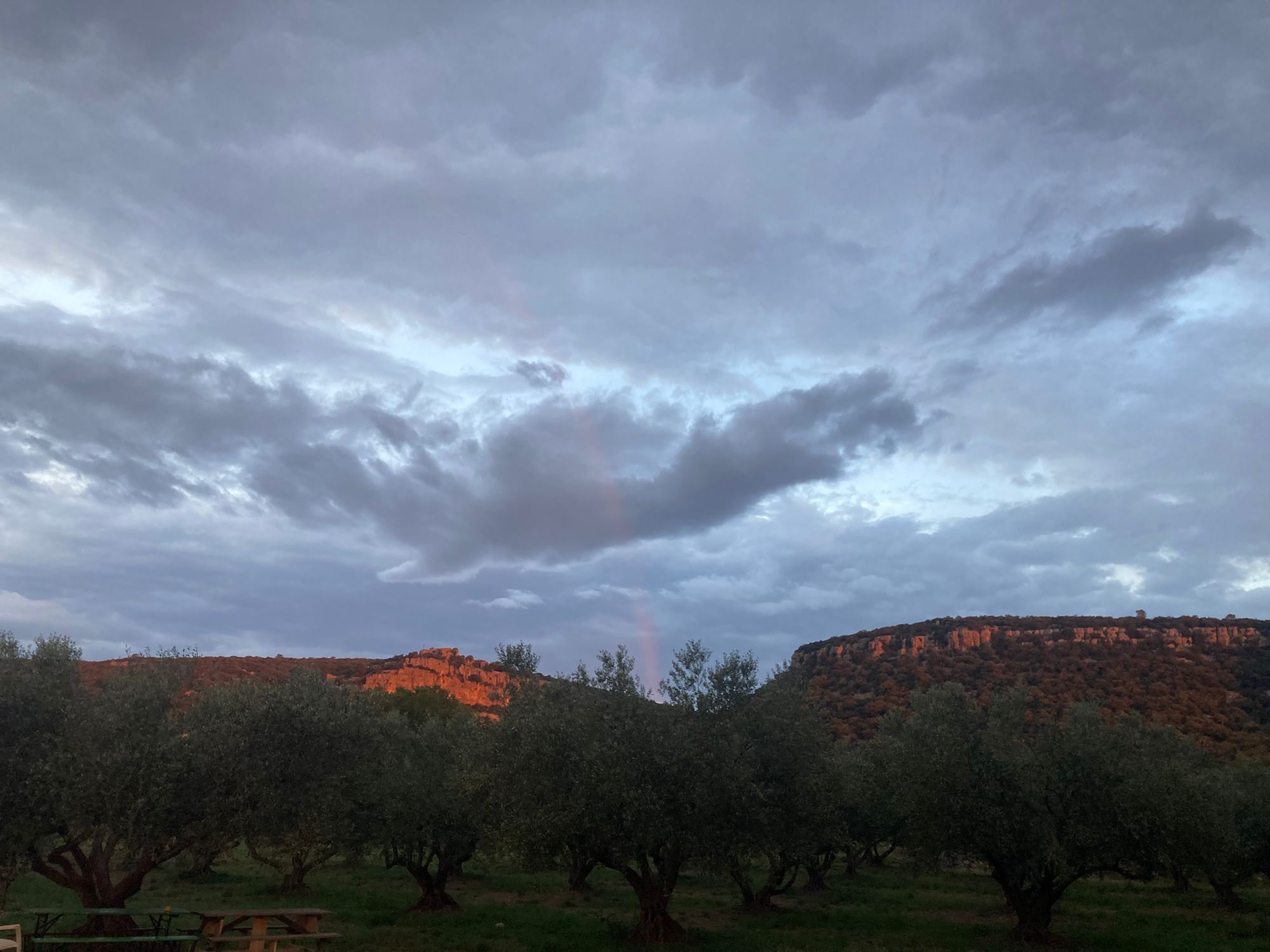
Can you tell me about where you are in the Languedoc, and the grapes, climate and traditions that define the region?
Corconne is a region with a very long tradition of both wine and olive oil. The terroir is very specific to this region because it's limestone and red clay - the limestone comes from cliff erosion. In the photo, you'll see a big mountain. At the bottom it's very thin soil of around 1 meter deep, but if you go down the plain it can reach around 5 meters, so these areas make very different kinds of wine. In terms of grapes, Cinsault, Carignan, Grenache, Syrah and Mourvèdre have all been present for quite a long time. These are the main grapes you'll find in our region.
Is there much of a natural wine scene there?
There is, but the region is very big. Every winemaker is around a 30 minute drive from the next, there's a big scene of natural winemakers near the city of Uzes and there's also a big scene in Souvignargues.
Can you describe the vineyard and its surroundings?
Mostly it's in the middle of garrigue (open shrubby vegetation) and my vines are on different plots but always surrounded by a lot of other plants - like small green oak trees or olive trees - so it's not just an ocean of vines.
What grapes go you grow and how many hectares do you work with?
I work with 3.5 hectares of Cinsault, Syrah, Grenache, Carignan, Vermentino, Colombard and Grenache Blanc.
Can you describe the soil and the climate?
It's limestone and red clay, typical of the region. I have a section with more clay than others, and some parcels that has a red sand-like soil. It's very a Mediterranean climate. Normally in spring, it's quite temperate, with climate change it's getting hotter and hotter. There should be dry summer with low rainfall in winter, but now spring tends to be really rainy, summer is really hot with no rain from March until around September and then in September we have the Mediterranean rain storms which typically arrive in winter, but are coming earlier and earlier.
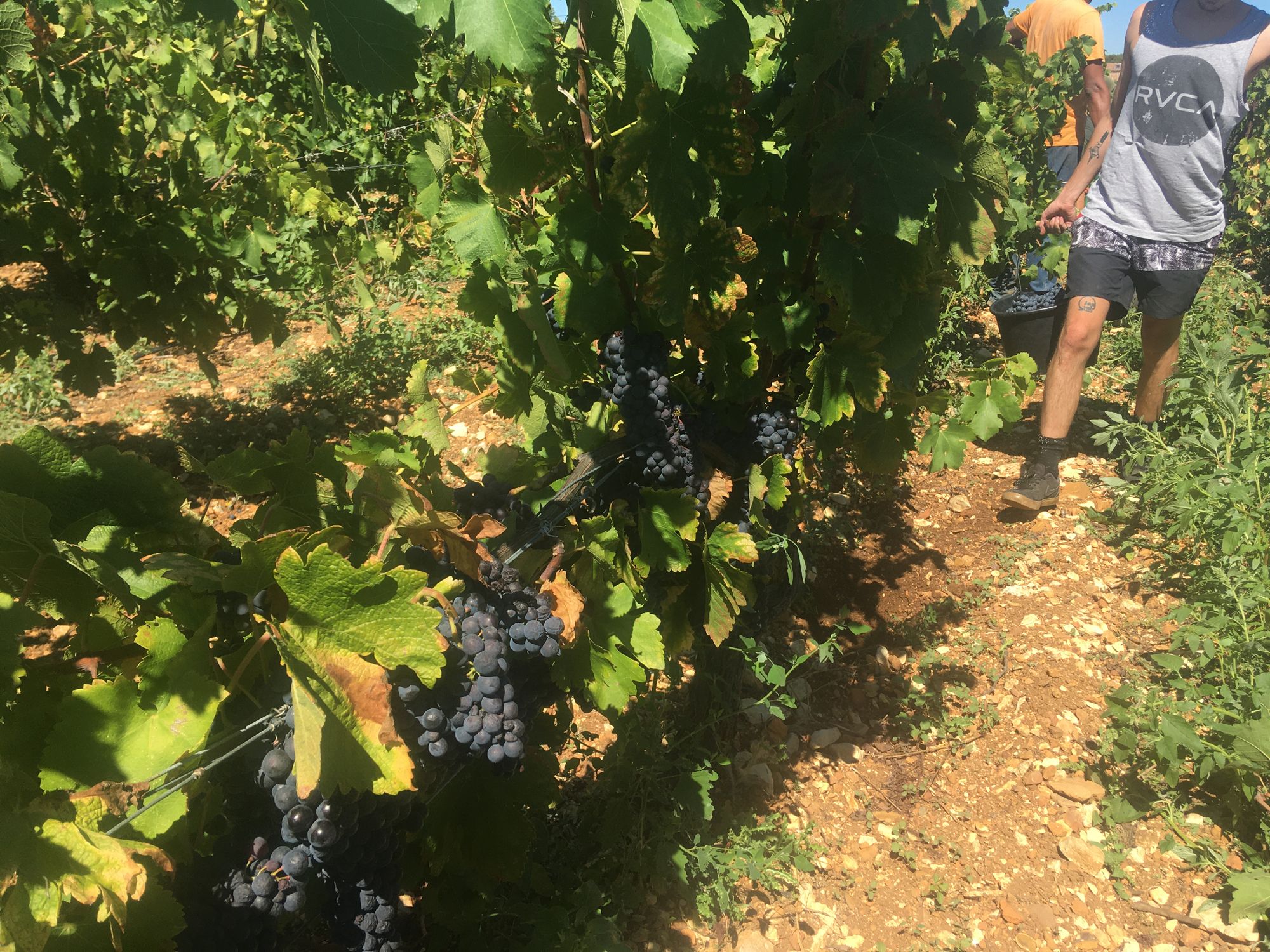
Which grapes have you used for this wine?
It's 100% Syrah. The vines are 20 years old. The average yield is between 15-20 hectolitres per hectare.
Can you talk me through the process of making this wine?
With climate change, I harvest earlier and earlier. I used to harvest Syrah around 15th September, but now I'm picking around the end of August, first week of September. Most of the time it's the latter. It's hand harvested in very small boxes, and I destem 50% of the grapes and the other 50% is left whole bunch. I put them into fibreglass vats and I do a pigeage after about 2 days. Then I don't touch anything for around 12 days so it can ferment with natural yeast and then after that, move the wine to my husband's cellar in the Loire Valley to age, also in fibreglass. I've tried it in wood and I wasn't very convinced, but I'd love to try ageing in concrete in future. I bottle around April or May.
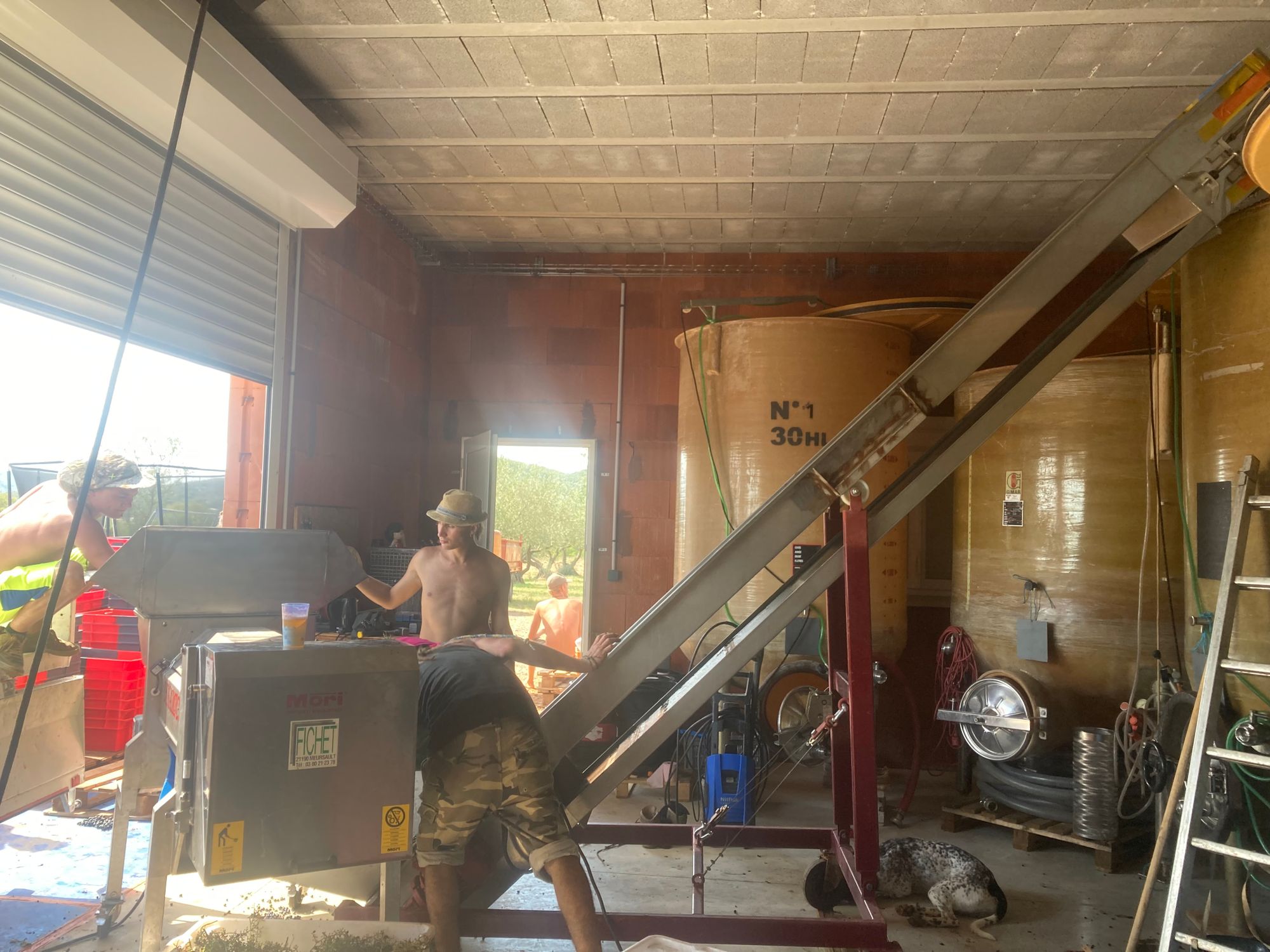
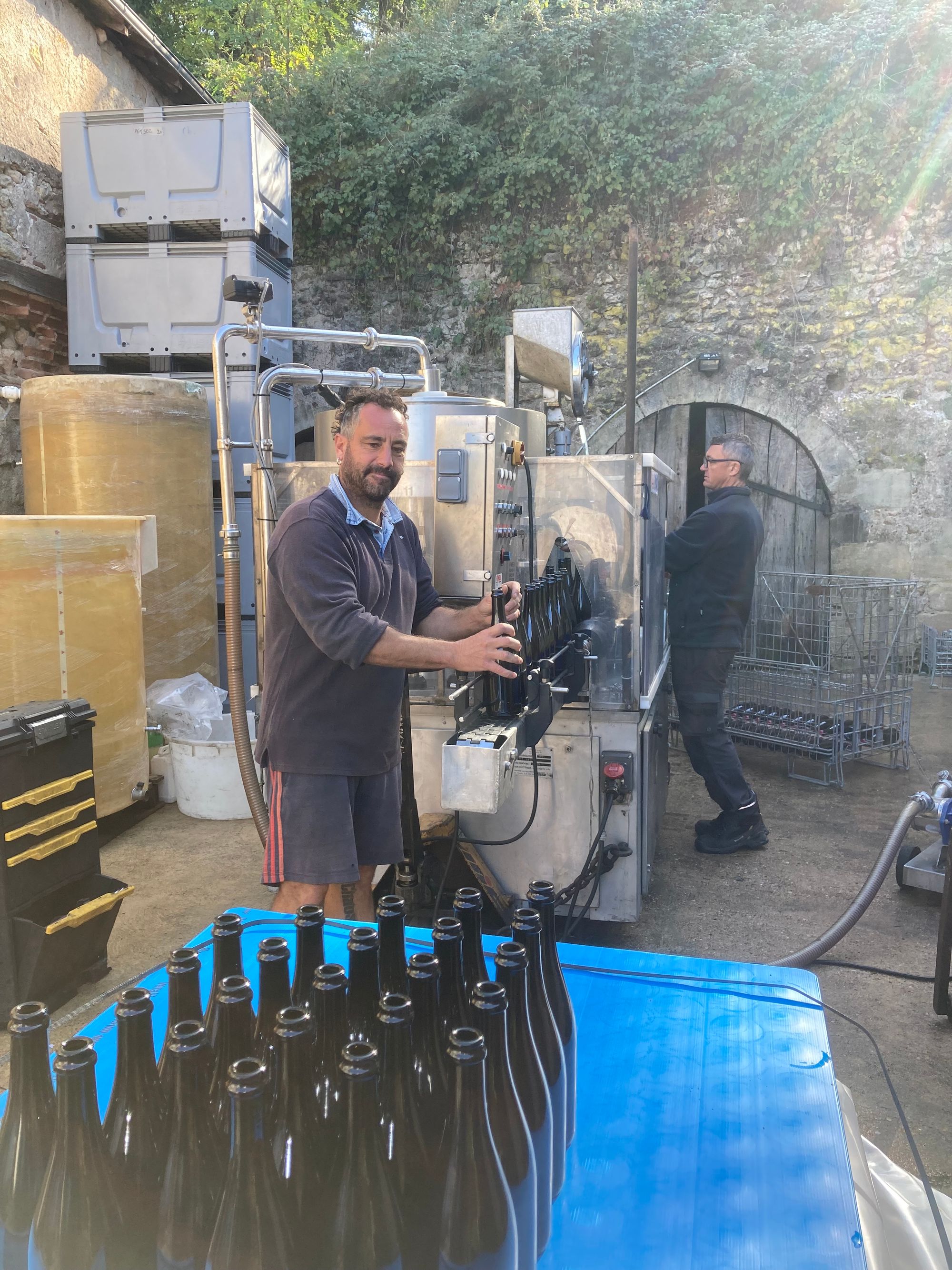
Do you use any sulfites and what are the total sulfites per liter?
I don't add any sulfites, so for naturally occurring sulfites, it's 16mg/L.
How would you describe the wine?
I don't make this wine every year because I like to make the kind of Syrah you can get in the Northern Rhone - I call it this my Cornas version! It has red berries in both flavor and aroma, and olive tapenade in flavor. I like when Syrah goes like this.
How does this vintage compare to others?
I made it in 2013, 2014, 2015, 2019 and 2021 and there won't be any in 2022 or 2023. I'll compare to the last three vintages as the others are too long ago and climate change has changed a lot. Compared to 2019, it's lighter - the air was less hot, so it's more fresh. In 2021, the yield was very low and it was more concentrated with less acidity, so 2019 and 2020 had quite a lot of acidity, 2021 not that much. As a result, I imagine you can keep 2019 and 2020 for longer than 2021.
When is it best enjoyed? Now or later, if people want to age it further in the bottle?
I think it could be aged for another 5 years, but not much longer. It's hard to say, but my first vintage was 2001 and there were some wines I was sure wouldn't age but I kept back because they were my first babies. The Cinsault is gone, but the Syrah from 2001 is quite good still. I guess since this is 2020, maybe another 5-10 years, but no longer. The best time to drink it would be this winter.
What’s the story behind the name of the wine, Anne A Wine Again?
It's called Anne A Wine Again. When I made my first wine I had no idea how to name them. One of my friends in the Loire has her own restaurant with her partner and I made her try the wine and she said you could drink it like pot (pot is a bottle with a capacity of 50cl) and said it could be a play on words with my name. So my first wine was a Cinsault called Pot d'Anne, the second one was a Grenache called Annagram, because it was a brain teaser to make, and when I showed her the next one she said ah there's a wine again, let's call it Anne A Wine Again, so that's how it happened.
Any food pairings you’d recommend?
It goes quite well with beef, like Burgundy beef, or lamb. And it would probably work well with pumpkin cooked with rosemary. And parsnip.
Isabelle's thoughts on Anne A Wine Again - A herbal (almost minty), perfumed Syrah, with undertones of scented violets. Reminiscent of a northern Rhône, this bottle is also starting to show hints of tertiary notes (dry rose, truffle) usually associated with age and maturity. Tannins are grippy but balanced, and a long finish makes for a delicious, full-bodied drop.
TOTAL SULFITES: 16mg/L

